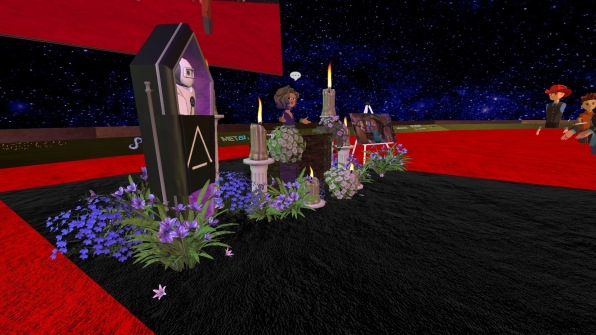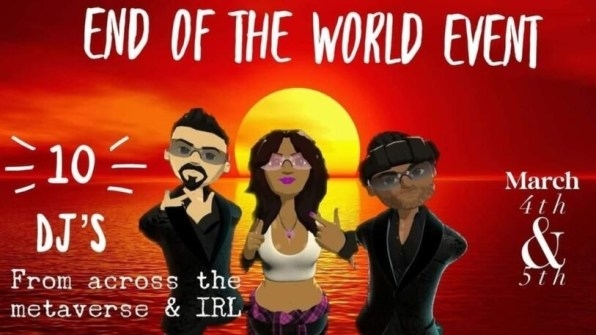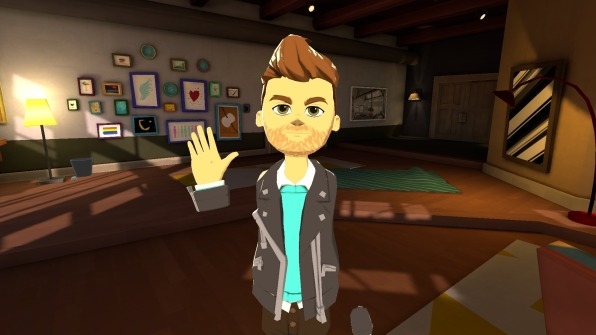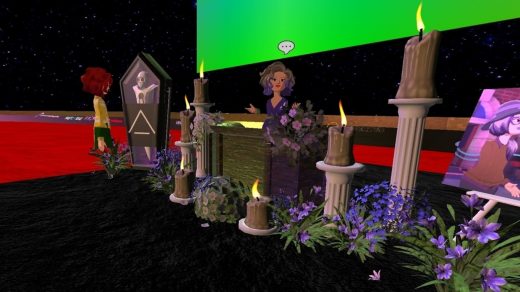What happens when a metaverse disappears?
By Janko Roettgers
A bugle played Taps. The crowd fell silent. Then, a coffin began floating down the aisle, as if carried by invisible pallbearers, until coming to a stop at a makeshift altar adorned with candles and flowers. The coffin was propped up, revealing under its transparent lid the iconic AltspaceVR robot avatar, and a short ceremony began.
This scene unfolded on the social VR platform AltspaceVR last weekend, where roughly 40 users and creators had come together to mourn its impending demise. Microsoft, which had acquired the VR platform in 2017, shut down AltspaceVR on Friday, March 10.
The last few days on AltspaceVR were marked by many such somber moments. Communities who had formed on the platform over the years held their final goodbye events, friends and VR acquaintances exchanged contact information to stay in touch, and more than a few people cracked end-of-the-world, doomsday jokes.

“Absolutely, there’s a world that’s ending,” says Athena Demos, CEO of Big Rock Creative, a VR startup slash artist community that has been putting on virtual versions of Burning Man in AltspaceVR since 2020. Demos led last weekend’s ceremony, telling her audience that the AltspaceVR community would always remember the memories it made on the platform.
“It’s bittersweet. It’s sad,” she tells Fast Company. “There was some magic there.”
AltspaceVR’s demise comes at a pivotal moment for VR and immersive media: Apple is widely expected to release its first mixed reality headset in the coming months, and Meta continues to pour billions of dollars into AR and VR hardware and software. However, Meta’s own social VR platform Horizon Worlds has struggled to gain traction, and some companies have soured on “the metaverse” and the potential for immersive digital communities altogether. In this context, the closure of AltspaceVR marks both the end of an era for early social VR platforms, and a learning opportunity for future metaverse endeavors.

Microsoft announced its plans to shut down AltspaceVR in January as a part of a broader set of cost-cutting measures that also included a retreat from several other VR initiatives, as well as the layoff of 10,000 employees. Microsoft said at the time that it would continue to build technology for avatar-based AR and VR enterprise services; a source familiar with the company’s immersive technology initiatives tells Fast Company that AltspaceVR’s eight-year-old platform had been struggling with a lot of technical debt.
The abrupt shutdown nonetheless has left a lot of users frustrated. “I think it’s shortsighted,” Demos says. “I don’t think they realized the actual value of what they [had].”
With a focus on events and communities, over the years AltspaceVR has hosted virtual red carpet film premieres, VR fashion shows, concerts, and even presidential debates. Comedian Reggie Watts used to stop by regularly, and a number of churches and faith-based communities held weekly services on AltspaceVR.
“I love Altspace,” professes Jeremy Nickel, a former Unitarian minister who began experimenting with meditation and mindfulness circles on the VR platform in 2016. Encouraged by the response of the AltspaceVR community, Nickel founded the VR meditation community EvolVR in 2017, and held around 4,000 events with tens of thousands of participants on AltspaceVR.
Both Nickel and Demos praise AltspaceVR for its civility, and the ability to keep trolls at bay. “They had really unique moderating tools that were well thought out and just worked,” Nickel says. “There’s something special about the community standards of Altspace,” Demos notes. “That just doesn’t exist on other platforms.”
AltspaceVR also attracted event creators with the ability to perform across multiple instances: A comedian could, for example, perform with his avatar in a VR comedy club—and then beam that performance in real time to multiple replicas of the club. This made it possible to have hundreds of people attend events in small, intimate settings, without the technical snags that would arise if too many avatars were in the same space at the same time. “Reproducing that on other platforms is really difficult,” Nickel says.
For AltspaceVR veterans, this week’s closure is also a bit of déjà vu. In mid-2017, AltspaceVR announced that it was forced to shut down after running out of money, only to be rescued at the last minute by Microsoft’s acquisition. “All of us have been holding our breath since then,” Nickel says. “It’s been almost too long of a goodbye at this point.”
During the eight years that AltspaceVR was up and running, virtual reality has evolved significantly. Initially, a relatively small number of early adopters were using expensive PC-based headsets to access the service in VR. Since 2020, Meta has reportedly sold close to 20 million stand-alone Quest 2 VR headsets, significantly lowering the barrier of entry to the medium. This has helped a number of other social VR platforms, including VRChat, Rec Room, and Meta’s own Horizon Worlds.
AltspaceVR event creators like Nickel, whose company got acquired by VR meditation startup Tripp last year, are now looking to guide their audiences to these other platforms. “We’re ready to move on,” he says.

For many of AltspaceVR’s users, finding a new home in VR does feel different than, say, switching out their preferred email service or search engine. Not only are they losing their avatars, which many personalized over years to reflect their looks or personalities, some of their favorite virtual worlds are also going away. “We’ve had weddings and funerals. People literally have taken their last breaths with our community,” Nickel explains. “The places where that happened are gone. That’s hard.”
VR evangelists have long talked about a future in which social VR worlds like AltspaceVR and its successors are interoperable, and users are able to take their avatars from one world to another. But with this vision of an all-connecting metaverse still out of reach, there may be some lessons in the demise of AltspaceVR, argues Nickel.
“We’re a meditation community. We’re trying to help people understand that change is the only constant,” he says. “It’s all just part of the journey, you know?”
(24)



